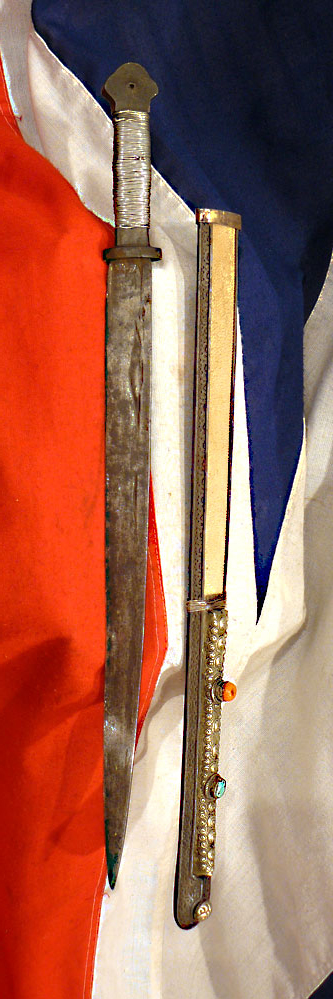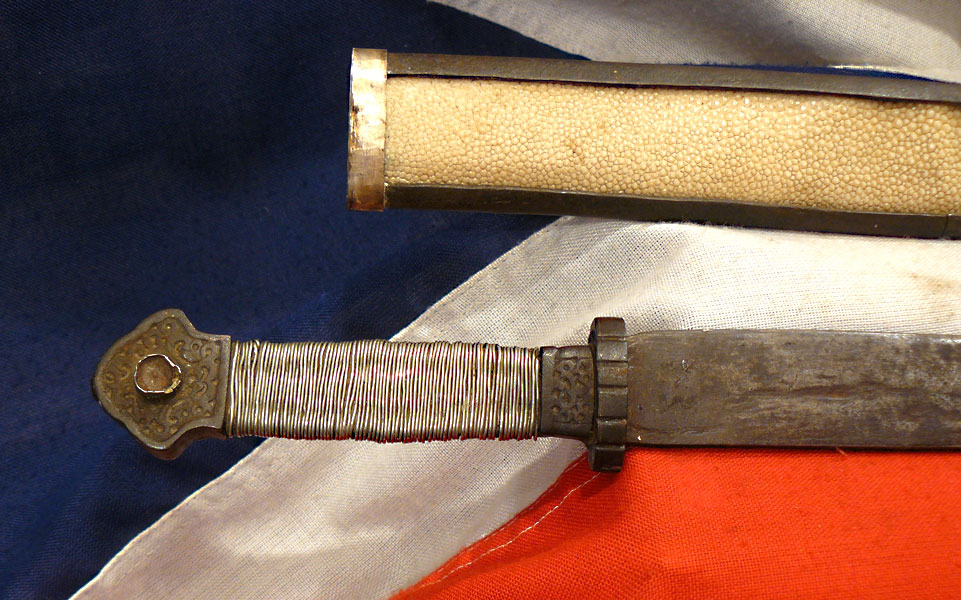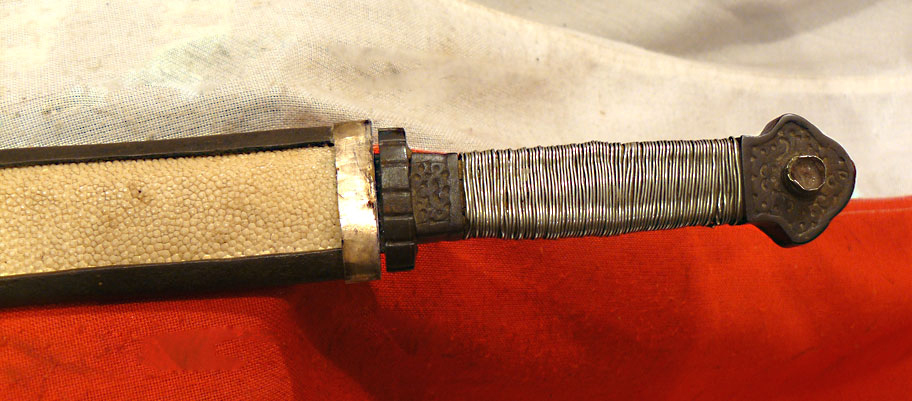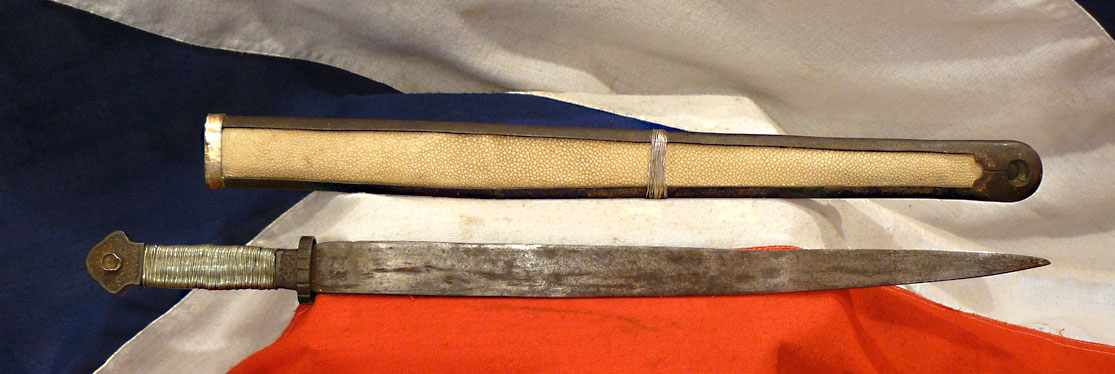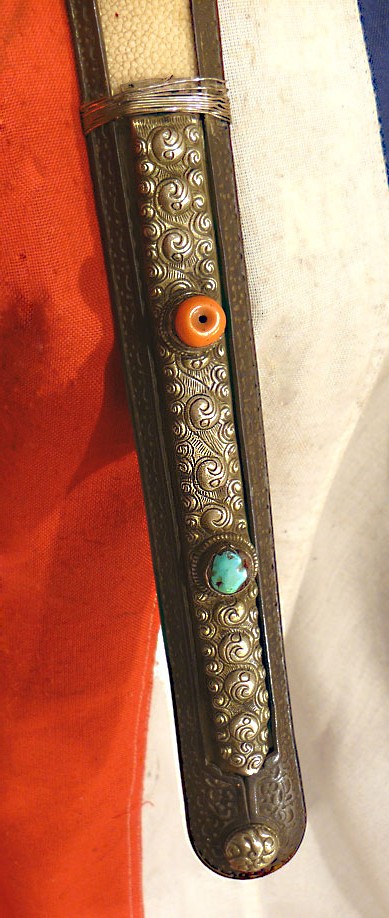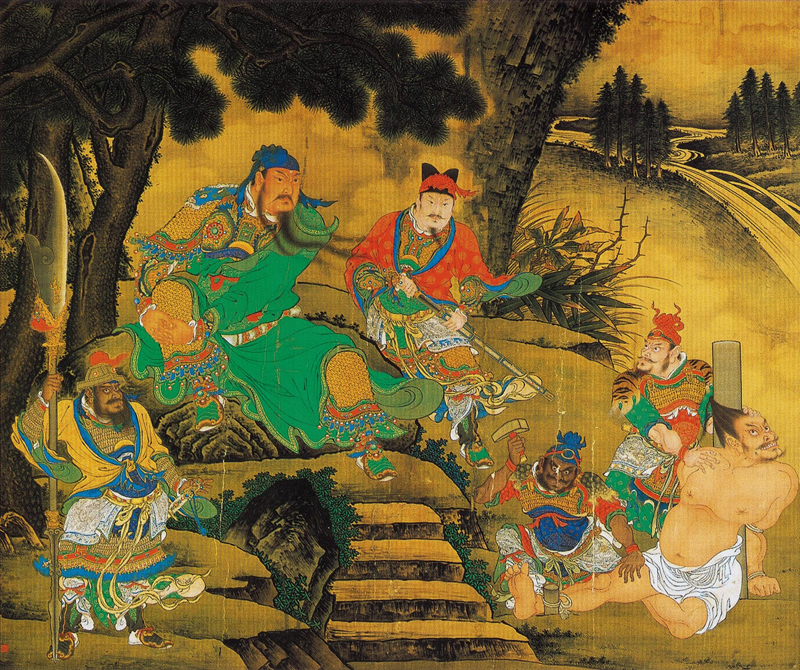Beautiful 17th to 18th Century Chinese Qing Dynasty Period Sword Of The Era Of Emperor Kangxi, With a Silver Wire Bound Hilt, and a Silver, Giant Rayskin, Coral & Turquoise Gem Set Panelled Scabbard, Typical of Eastern Tibet
Likely the sword of a Chinese or Tibetan noble or high ranking warrior. A functional combat sword yet with elements of extravagant decor, that clearly shows to high status of its owner, during the early Qing also called Ching dynasty, that followed the late Ming dynasty.
Steel hilt with silver wire bound grip, stylised traditional Chinese batwing engraved pommel and steel mounting bands of the scabbard, the scabbard is panelled in giant rayskin, and a bottom chape in repousse silver metal, with decor of swirling winds, mounted with cabouchons of torqoise and coral to one side. The scabbard also has some silver wire re-enforced binding. This a most rare, beautiful and original antique Chinese sword. Original surviving antique swords are extremely scarce due to the Cultural Revolution in the mid 20th century in China, when 99.99% of all existing antique swords were destroyed or ordered melted down for their metal content.
Of course the manufacture and sale of reproduction Chinese swords in China is a thriving market, many intimated and sold to be old or original, but very sadly, none are.
Old original Chinese antique arms very rarely survive, and now are generally only to be seen in the biggest and best museums. The fittings are very much in the form popular in the south to eastern region of the old Chinese empire in the Xizang province, and Eastern Tibet. This sword is a textbook representative example of the familiar Chinese form, well made and of good quality. The blade has traces still visible of the prominent ‘hairpin’ lamination pattern, the hallmark of traditional blades of the region, consisting of seven dark lines alternating with six light lines, caused by the different types of iron that were combined during the forging process. This was formed by combining harder and softer iron, referred to as "male iron" and "female iron" in traditional ancient texts from the region, which was folded, nested together, and forged into one piece in a blade-making technique called pattern welding. The hilts are often made of engraved silver set with coral or turquoise, or in some rare instances are intricately chiseled and pierced in iron that is damascened in gold and silver. The different styles of swords that were once found in greater China can be distinguished by several basic features, which include the type of blade, the form of hilt, the type of scabbard, and how the sword was designed to be worn. Traditional texts divide swords into five principal types, each of which has a main subtype, for a total of ten basic types. These are in turn subdivided into dozens of further subtypes, many of which may, however, reflect legends and literary conventions rather than actual sword forms.
A few excellent examples of arms and armour from the region can be found in museum collections today. Other types were preserved for ceremonial occasions, the most important of which was the Great Prayer Festival, a month-long event held annually in the local capitol. Historical armour and weapons were also very fortunately preserved due to the long-standing tradition of placing votive arms in monasteries and temples, where they are kept in special chapels, known as gonkhang (mgon khang), and dedicated to the service of guardian deities. Although there are representatives of the Manchus in Tibet, the region is largely left to function independently and does so for the next 200 years.
Currently in one of the worlds greatest museums, the Metropolitan Museum of Art in New York, there is an exhibition of Chinese & Tibetan arms and armour. Item 36.25.1464., within the exhibition, is a near identical sword, dated as 17th century, used until the 19th century.
The Qing dynasty, officially the Great Qing pronounced Ching, was the last imperial dynasty of China and Mongolia. It was established in 1636, and ruled China proper from 1644 to 1912. The Qing multi-cultural empire lasted for almost three centuries and formed the territorial base for modern China. It was the fifth largest empire in world history. The dynasty was founded by the Manchu Aisin Gioro clan in Manchuria. In the late sixteenth century, Nurhaci, originally a Ming Jianzhou Guard vassal, began organizing "Banners", military-social units that included Manchu, Han, and Mongol elements. Nurhaci formed the Manchu clans into a unified entity. By 1636, his son Hong Taiji began driving Ming forces out of the Liaodong Peninsula and declared a new dynasty, the Qing.
In an unrelated development, peasant rebels led by Li Zicheng conquered the Ming capital, Beijing, in 1644. Rather than serve them, Ming general Wu Sangui made an alliance with the Manchus and opened the Shanhai Pass to the Banner Armies led by the regent Prince Dorgon. He defeated the rebels and seized the capital. Resistance from the Southern Ming and the Revolt of the Three Feudatories led by Wu Sangui delayed the Qing conquest of China proper by nearly four decades. The conquest was only completed in 1683 under the Kangxi Emperor reign (1661-1722). The Ten Great Campaigns of the Qianlong Emperor from the 1750s to the 1790s extended Qing control into Inner Asia.
During the Qianlong Emperor reign (1735-1796) the dynasty reached its apogee, but then began its initial decline in prosperity and imperial control. The population rose to some 400 millions, but taxes and government revenues were fixed at a low rate, virtually guaranteeing eventual fiscal crisis. Corruption set in, rebels tested government legitimacy, and ruling elites failed to change their mindsets in the face of changes in the world system. Following the Opium Wars, European powers imposed "unequal treaties", free trade, extraterritoriality and treaty ports under foreign control. The Taiping Rebellion (1850-1864) and the Dungan Revolt (1862-1877) in Central Asia led to the deaths of some 20 million people, most of them due to famines caused by war. In spite of these disasters, in the Tongzhi Restoration of the 1860s, Han Chinese elites rallied to the defense of the Confucian order and the Qing rulers. The initial gains in the Self-Strengthening Movement were destroyed in the First Sino-Japanese War of 1895, in which the Qing lost its influence over Korea and the possession of Taiwan. New Armies were organised, but the ambitious Hundred Days' Reform of 1898 was turned back in a coup by the conservative Empress Dowager Cixi. When the Scramble for Concessions by foreign powers triggered the violently anti-foreign "Boxers", the foreign powers invaded China, Cixi declared war on them, leading to defeat and the flight of the Imperial Court to Xi'an.
Overall 23 3/4 inches long.
Code: 22307


